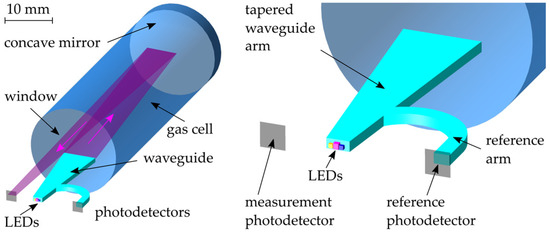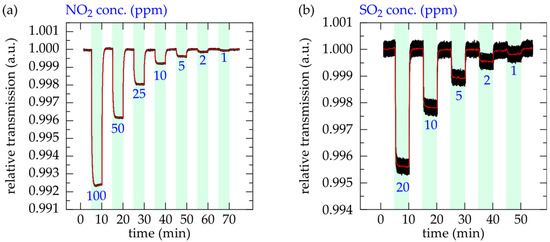Abstract
Continuing advances in the development of light-emitting diodes (LEDs) in the deep ultraviolet spectral range (DUV) enable miniaturized, mobile, and cost-effective DUV gas sensors. Efficient light coupling, guiding, and splitting plays a key role for stable sensor systems and is realized by low-loss silica based waveguides, fabricated by ultrashort pulsed laser etching and laser polishing. The tapered waveguide leads to a significantly higher efficiency with less required space compared to optical fibers or free beam setups, respectively. Toxic gases like NO2 and SO2 were successfully measured down to 1 ppm utilizing LEDs with wavelengths of 395 nm and 280 nm.
1. Introduction
The optical sensors market is growing steadily. Valued over USD 15.4 billion in 2015, a compound annual growth rate of 7.5% is estimated between 2016 and 2024 [1]. One reason for this growth is the successful implementation of semiconductor based LEDs as a lightweight, compact, efficient, and cost-effective light source and the demand for miniaturized sensors. Up to now, many optical sensors are based on LEDs emitting in the visible and infrared region, e.g., heart rate monitors of smartwatches or smoke detectors. In contrast, due to a lack of suitable light sources, current optical sensors working in the DUV have been engineered with gas discharge lamps, limiting the adoption by the mass market due to their long warmup times, large sizes, short lifetimes and high cost.
However, in recent years, several groups have been successfully working on the development of DUV-LEDs with wavelengths below 240 nm [2,3,4] and even 210 nm [5]. These LEDs are based on the wide bandgap material system AlGaN and their wavelengths can be controlled by the Al mole fraction in the AlGaN quantum well (QW) active region [6]. As a result, absorption peaks of harmful gases in the DUV have been exploited by LED based sensors to selectively measure the concentration of O3, NO2 and NO [7,8]. The spectral absorption measurement offers advantages over conventional electrochemical sensors, which are limited regarding selectivity and cross-sensitivity [9]. For instance, NOx sensors unselectively measure NO and NO2 and show significant cross-sensitivity to NH3 [10].
On the other hand, DUV-LEDs still exhibit fairly low efficiencies and emission. Thus, along ongoing optimizations of the LEDs, efficient sensor systems are required to couple, guide and split light. So far, publications on DUV-LED gas sensors base on optical fibers [7] or lens based setups [8] and require much space. In contrast, this work reports on a miniaturized optical gas sensor utilizing silica waveguides and demonstrates its functionality by measuring NO2 and SO2 down to 1 ppm using LEDs with wavelengths corresponding to the respective absorption peaks of the two gases.
2. Sensor Design
2.1. Sensor Principle
The presented sensor exploits the Beer-Lambert law, which describes light absorption in a medium like a gas, depending on the path length l through the absorbing gas, the wavelength dependent specific absorption coefficient α(λ) of the gas, and the gas concentration c. It is given by
whereby I0 and I1 denote the light intensities before and after absorption, respectively. Two reference methods are used to stabilize the sensor signal and realize high resolutions [11]. First, in order to compensate intensity fluctuations of the LED due to temperature changes and ageing effects, both I0 and I1 have to be measured by splitting the light path. In this work, a reference waveguide arm splits the light, which is coupled into the waveguide from several LEDs, into the main measurement path and the reference path (cf. Figure 1). While the reference path guides light to the reference detector, the major part of the light is guided through the waveguide and a silica window into the gas volume. In order to double the path length while keeping the sensor compact, a concave mirror at the end of the 55-mm-long absorption cell reflects and collimates the light back to the measurement detector.

Figure 1.
Schematics of the DUV-LED based gas sensor utilizing a tapered waveguide: the light is splitted into a main path and a reference path. The tapering improves the efficiency by light collimation. The absorption length is doubled by use of a concave mirror at the back face of the gas cell.
Second, in order to compensate non-gas-specific transmission changes, e.g., due to a hazed window, a reference LED with a non-gas-sensitive wavelength is used and the two (or more) LEDs are turned on and off alternately. Finally, the referenced relative transmission T is calculated by
with superscripts M and R denoting intensities measured on the measurement and reference detector, respectively. Subscript indices Gas and Ref indicate the specific active LED (gas-specific or non-gas-specific) and dark the intensity measured without any active LED (dark current measurement).
A 20-bit, two-channel simultaneous sampling measurement system based on the DDC112 analog-to digital converter (Texas Instruments) and a sbRio-9632 development board (National Instruments) was used to control the LEDs and collect data. It is described in detail in Reference [12].
2.2. Optical Simulations for Optimal System Efficiency
The 1-mm-thick waveguide, which is fabricated by ultrashort pulsed laser etching and subsequently laser polishing to achieve smooth sidewalls [13], consists of a DUV transparent fused silica core and ambient air cladding, leading to a high refractive index contrast Δ of 0.28. Using ray-tracing simulations (Zemax Optics Studio), a much higher coupling efficiency of about 73% is achieved compared to an efficiency of about 4% using a standard glass fiber with a small Δ of 0.01. At the same time, curves with radii down to 0.6 mm can be implemented with the presented system, while the simulated fiber shows the same loss already at 53.6 mm limiting the miniaturization [13].
The efficiency of the measurement path is doubled by light collimation in a tapered waveguide. The front width is 2 mm, while the back is expanded to 7 mm. This kind of collimation has advantages over lens or reflector based collimators due to its integrated light homogenizing properties.
2.3. Optoelectronic Components of the Sensor
The absorption spectra of NO2 and SO2 exhibit maxima at emission wavelengths around 400 nm and 280 nm, respectively. Correspondingly LED-chips with wavelengths of 395 nm (EOLC-395-34, Epigap, Berlin, Germany), 290 nm (Research samples, Ferdinand Braun Institut, Berlin, Germany), and 280 nm (EOLC-280-39, Epigap) were implemented. Optionally, one non-gas-selective reference LED-chip at a wavelength of 597 nm (LYP47F, Osram, Regensburg, Germany) was used. TO5-packaged silicon photodetectors (S1226-5BQ, Hamamatsu, Japan) with a photosensitive area of 2.4 mm × 2.4 mm were utilized to measure the light intensity.
One advantage of the presented sensor is its platform idea. Depending on the use-case appropriate gas specific LEDs are chosen. In this work two versions were used to measure NO2 and SO2. For measuring NO2, LED-chips with wavelengths of 395 nm (gas) and 595 nm (reference) and for the measurement of SO2, with 280 nm/290 nm (gas) and 395 nm (reference) were assembled.
3. Gas Measurements
Measurement of NO2 and SO2
A total gas flow of 1000 sccm was applied, consisting of a variable amount of NO2 in N2 with 20% O2 as carrier gas. The two LEDs are activated serially and photodetector currents are integrated leading to a sensor sample rate of about 1 Hz. NO2 concentrations from 100 ppm down to 1 ppm were applied and successfully measured by the sensor as shown in Figure 2a including drift compensation.

Figure 2.
Sensor signal (black) and averaged (n = 10) signal (red) for measuring different concentrations of (a) NO2 (395-nm-LED) and (b) SO2 (280-nm-LED).
Due to the available gas cylinder, a lower flow rate of 500 sccm was applied for measuring SO2. SO2 concentrations of 20 ppm and lower were applied and 1 ppm could be resolved (cf. Figure 2b).
4. Conclusions
The use of LEDs and a tapered silica waveguide significantly decreases the sensor size. NO2 and SO2 concentrations were successfully measured down to 1 ppm and further measurements in the sub-ppm regime and studies on cross-sensitivities are currently being investigated.
Acknowledgments
This work has been funded by the German Federal Ministry of Education and Research within the Project UltraSens (Nos. 13N12587 and 13N12588). The authors thank Hendrik Krüger, Marian Rabe, Eric Ebert, Nils Damaschke, and Hartmut Ewald from the Institute of General Electrical Engineering, University of Rostock, Germany for developing and supplying electronics and software for controlling the sensor and performing data collection, Maximilian Amberger, Corporate Sector Research and Advance Engineering, Robert Bosch GmbH, Germany, for the assembly of LEDs and Myriam Kaiser and Roman Priester from TRUMPF GmbH + Co. KG, Ditzingen, Germany for modifying silica wafers using the ultrashort pulsed laser optics TOP-Cleave.
Conflicts of Interest
The authors declare no conflict of interest. The founding sponsors had no role in the design of the study; in the collection, analyses, or interpretation of data; in the writing of the manuscript, and in the decision to publish the results.
References
- Global Market Insights, Ocean View Delaware, United States. Optical Sensors Market Share, Size—Industry Report 2024; Industry Analysis Report; Report ID GMI755; Sussex County, DE, USA, 2016. [Google Scholar]
- Mehnke, F.; Kuhn, C.; Guttmann, M.; Reich, C.; Kolbe, T.; Kueller, V.; Knauer, A.; Lapeyrade, M.; Einfeldt, S.; Rass, J.; et al. Efficient charge carrier injection into sub-250 nm AlGaN multiple quantum well light emitting diodes. Appl. Phys. Lett. 2014, 105, 051113. [Google Scholar] [CrossRef]
- Reich, C.; Guttmann, M.; Feneberg, M.; Wernicke, T.; Mehnke, F.; Kuhn, C.; Rass, J.; Lapeyrade, M.; Einfeldt, S.; Knauer, A.; et al. Strongly transverse-electric-polarized emission from deep ultraviolet AlGaN quantum well light emitting diodes. Appl. Phys. Lett. 2015, 107, 142101. [Google Scholar] [CrossRef]
- Hirayama, H.; Noguchi, N.; Yatabe, T.; Kamata, N. 227 nm AlGaN light-emitting diode with 0.15 mW output power realized using a thin quantum well and AlN buffer with reduced threading dislocation density. Appl. Phys. Express 2008, 1, 051101. [Google Scholar] [CrossRef]
- Taniyasu, Y.; Kasu, M.; Makimoto, T. An aluminium nitride light-emitting diode with a wavelength of 210 nanometres. Nature 2006, 441, 325–328. [Google Scholar] [CrossRef] [PubMed]
- Shur, M.S.; Gaska, R. Deep-ultraviolet light-emitting diodes. IEEE Trans. Electron Devices 2010, 57, 12–25. [Google Scholar] [CrossRef]
- Degner, M.; Damaschke, N.; Ewald, H.; Lewis, E. High resolution LED-spectroscopy for sensor application in harsh environment. In Proceedings of the IEEE Instrumentation and Measurement Technology Conference, Austin, TX, USA, 3–6 May 2010; pp. 1382–1386. [Google Scholar]
- Mehnke, F.; Guttmann, M.; Enslin, J.; Kuhn, C.; Reich, C.; Jordan, J.; Kapanke, S.; Knauer, A.; Lapeyrade, M.; Zeimer, U.; et al. Gas Sensing of Nitrogen Oxide Utilizing Spectrally Pure Deep UV LEDs. IEEE J. Sel. Top. Quantum Electron. 2017, 23, 29–36. [Google Scholar] [CrossRef]
- Hawe, E.; Dooly, G.; Fitzpatrick, C.; Chambers, P.; Lewis, E.; Zhao, W.Z.; Sun, T.; Grattan, K.T.V.; Degner, M.; Ewald, H.; et al. Measuring of exhaust gas emissions using absorption spectroscopy. Int. J. Intell. Syst. Technol. Appl. 2007, 3, 33–51. [Google Scholar] [CrossRef]
- Zhang, H.; Wang, J. NOx sensor ammonia-cross-sensitivity factor estimation in diesel engine selective catalytic reduction systems. J. Dyn. Syst. Meas. Control 2015, 137, 061015. [Google Scholar] [CrossRef]
- Degner, M. LED-Spektroskopie für Sensoranwendungen: Am Beispiel der In-Situ Abgasdetektion für Verbrennungsmaschinen; Mensch und Buch Verlag: Berlin, Germany, 2010; p. 104. [Google Scholar]
- Krüger, H.; Rabe, M.; Ebert, E.; Busch, P.; Damschke, N.; Ewald, H. A flexible measurement system for absorption spectrometry using LED light sources and a high accuracy two-channel ADC for simultaneous sampling. In Proceedings of the 2015 9th International Conference on Sensing Technology (ICST), Auckland, New Zealand, 8–10 December 2015; pp. 652–655. [Google Scholar]
- Elmlinger, P.; Schreivogel, M.; Schmid, M.; Kaiser, M.; Priester, R.; Sonström, P.; Kneissl, M. Comparison of fabrication methods for microstructured deep UV multimode waveguides based on fused silica. SPIE Photonics Eur. 2016, 98880A. [Google Scholar] [CrossRef]
© 2017 by the authors. Licensee MDPI, Basel, Switzerland. This article is an open access article distributed under the terms and conditions of the Creative Commons Attribution (CC BY) license (https://creativecommons.org/licenses/by/4.0/).